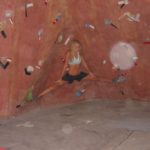starting with safety gear indoors, then progressing to bouldering, scrambling, and free ascents
–
Table of Contents:
- Introduction
- Vocabulary
- Progression
- Example Images / Visual Aids
–
Introduction:
I (High King Auz) have enjoyed climbing since I was very young. I climbed the baby-blocking “security gates”, then trees, then onto rooftops, and eventually even up buildings under construction, and the construction cranes beside them. When it came time for me to climb obstacles in the military, it was entirely easy and fun for me.
Climbing, like swimming and sex, uses the entire body, thus it is one of the best forms of exercise, and one of the surest indicators of excellent, if not peak, health.
In our realm, there is a lot to climb; instead of regular stairwells, we have AIOWs. There are also underground climbing facilities, above-ground climbing-areas, and many school/training drills/practices requiring climbing. This course is designed to help everyone in our realm get professional coaching in how to comfortably and safely climb a great variety of structures, whether they intend to eventually try climbing outdoors on steep slopes and cliffs or not.
–
Vocabulary:
- anchor: a point on top of a climb with fixed bolts or removable protection (like a sling around a sturdy tree).
- belay: securing the rope while your partner climbs. You’ll have a belay device that provides friction to the rope system—if your partner falls, the device will lock itself or help you support their weight.
- beta: a specific step-by-step description of a climb or a sequence. This is information provided from a guide book or a fellow climber (e.g.: “Hey, man, what’s the beta on that 5.12 over there?”).
- cam: a mechanical, spring-loaded piece of climbing protection that fits into the cracks and holes in a rock wall and secures a section of rope to that area of the wall in the event of a fall.
- carabiner: a snap-link piece of metal that connects your rope to your protection (also called a “biner”).
- crimp: a small ledge where you literally crimp your fingers, bending them to put pressure on your knuckles with a tight grip (e.g. “Ugh, that climb was way too crimpy; my fingers are killing me!”).
- crux: the hardest part of a climb. The crux can appear anywhere along the climb, sometimes it’s the first move.
- flash: to send, or complete, a pitch on your first try with the help of some beta.
- gaston: a climbing technique where the fingers face inward, like you’re trying to pry open elevator doors from the middle.
- heel hook: placing your heel on or around a rock feature and pulling, most common on overhanging rock.
- jug: a climber’s favorite feature: a large hold that’s easy to grasp.
- pitch: a unit of measure for the length of a climb as one full length of your rope. This measurement is interpretive, and can range from 30 feet to 1,000 feet (and even longer). A multi-pitch climb is one where you’ll stop midway up a rock route and pull up rope before starting another pitch.
- pocket: a small inset hole or rock hollow that you can probably only manage to get a finger or two in.
- protection: devices and tools used to reduce the risk of climbing and protect others while you climb. This includes items like nylon webbing, cams, bolts and other tools of the trade.
- quickdraw: a piece of nylon webbing with loops at each end for carabiners. You’ll use this to clip into protection.
- smear: to drag your entire foot along the wall to offer a boost between proper holds or crimps.
- sport climbing: climbing that entails fixed protection, typically drilled-in bolts.
- trad climbing: Traditional climbing might be the most encompassing form of climbing since you can do it almost anywhere. There is not permanent man-made protection, so as you climb, you’ll use climbing gear to create your own. This is also an environmentally friendly type of climbing, as it doesn’t harm the natural features of a rock wall.
Additional vocabulary is here.
–
Progression:
ICVs are always watching and ready to gracefully catch anyone who might fall.
General:
- indoor climbing-gym walls (in this LHS classroom/floor)
- indoor climbing-gym overhangs
- multi-level/story climbing-gym walls and overhangs (in the Silos Network)
- parking-garage stairwells (such as the one that is part of the Training Tower)
- parking-garage exteriors
- construction cranes (in the PK Playground)
- outdoor climbing-gym walls (of the Cliff-dwellings)
- outdoor climbing-gym overhangs (in the Main Canyon)
- tallest outdoor climbing (Devils Tower II)
- skyscraper interiors (of Sotu)
- skyscraper exteriors (BASE-jumping parachute-packs are worn)
- inverted/hanging skyscrapers
- ground-scrapers (of the Under-dome)
By School-year:
- Definitions
- Belaying
- Indoor
- Dark Silo
- Flooding Silo
- Burning Silo
- Rolling Wall
- Morphing Grips
- Timed, Speed
- Races
- Random Stair Widths / Angles
- Urban
- Exodus
- Cave
- Skyscraper
- MMU, Outer Space, & Zero Gravity (2 dif things)
–
link to ICGM Gym
–
–


